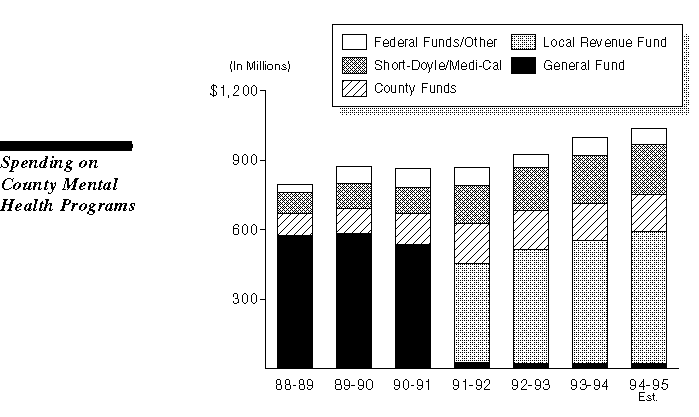
 Legislative Analyst's Office
Legislative Analyst's Office
Proposition 99, approved by the voters in November 1988, provides a major funding source for health programs in California. Its basic provisions are outlined below.

Smoking has declined in California, a trend almost certainly accelerated by the imposition of the surtax in 1989. As a result, annual surtax revenues have declined by about 25 percent in the five years since enactment of the measure--from just over $600 million in 1989-90 to about $450 million for 1994-95. The large carryover balance shown in the figure for 1989-90 and 1990-91 was due to the accumulation of revenues in advance of program expenditures.
Legislation appropriating Proposition 99 revenues for 1994-95 specifies that the funding level for certain programs will not be reduced during the next two years if revenues from the surtax are less than anticipated. (Other programs are subject to across-the-board reductions.) These "protected" programs are:

Due to the continuing drop in revenues, overall expenditures supported by the Proposition 99 surtax have declined significantly since passage of the measure. Expenditures for most primary care activities and for county indigent health services have absorbed most of the decline, in part because they accounted for the largest portion of expenditures. For example, funding for the California Healthcare for Indigents Program, the major Proposition 99 program for county indigents, has declined by half since 1989-90 (from $337 million to about $160 million in 1994-95). Expenditures for public health and health education also have declined since 1990-91, although funding for one of these programs--the anti-smoking media campaign--has remained relatively steady.
In contrast, expenditures for the Access for Infants and Mothers Program (a state- operated health insurance program) have increased annually since the program began in 1990- 91 to $68.6 million in 1994-95.

The number of years of potential life lost due to Acquired Immune Deficiency Syndrome (AIDS) has risen dramatically over the past ten years. Death from AIDS was the fifth highest cause of lost years of life in 1988; by 1991, it had climbed to second--behind cancer.
The U.S. Public Health Service estimates that the lifetime cost of treating a person with AIDS from diagnosis to death is $119,000.

The state hospital population has decreased significantly since 1991-92, when counties were given a greater share of costs for mental health programs and more flexibility to determine both the number of hospital bed-days they purchase from the state and the type of unit (acute, subacute, etc.) in which their patients are placed. For example, the total number of beds purchased by the counties for "civil commitment" patients (supported by county funds) has decreased from 2,423 in 1991-92 to 1,450 in 1994-95--a reduction of 40 percent in three years. As the utilization of state hospitals has declined, counties have been choosing less restrictive, and generally less costly, local treatment settings for their mental health patients.
Total spending on county mental health programs has increased from $865 million in 1990-91 to an estimated $1 billion in 1994-95, which is an average annual increase of 4.7 percent. The chart also shows that the Short-Doyle/Medi-Cal program--which provides federal reimbursements to counties for mental health services to Medi-Cal beneficiaries--nearly doubled during that same time period due primarily to expansion of the number of services eligible for reimbursement. The 1991-92 realignment legislation eliminated a total of $750 million in General Fund support for mental health services and established a Local Revenue Fund (state sales tax and vehicle license fee revenues) to support the increased financial obligations of counties.
Individuals with developmental disabilities reside in developmental centers (DCs) or receive services in the community through regional centers. As shown in the graph, the number of clients residing in the community has been increasing in recent years, and will grow significantly (23 percent) between 1993 and 1994 for clients under three years of age. This was due primarily to the implementation, in October 1993, of Part H of the federal Individuals with Disabilities Education Act, which:
Due primarily to the settlement of the Coffelt v. Developmental Services lawsuit, there has been an increase in the placement of DC residents in the community and a significant decrease in admissions to DCs. The DC population is anticipated to decrease from 6,544 at the end of 1991-92 to an estimated 5,265 residents at the end of 1994-95--a reduction of 20 percent in three years.
Of the developmental center clients placed in the community in 1993-94, 63 percent were placed either in intermediate care facilities (licensed medical facilities) or in the highest service category ("level 4") of community care facilities. The average cost for a DC resident is about $92,000 per year, while the average cost for a DC client placed in the community is estimated to be approximately $45,000 per year.
Heroin and alcohol users constituted 42 percent and 30 percent, respectively, of total admissions to treatment programs in 1993-94, while amphetamine and cocaine users each accounted for approximately 10 percent of admissions.
About 50 percent of all clients who received treatment in 1993-94 first used the drug before age 18. This suggests that prevention efforts should be targeted towards school-age youth.
The figures show that Whites constituted 78 percent of amphetamine users, 57 percent of alcohol users, and 45 percent of heroin users entering treatment programs. On the other hand, Blacks were 57 percent of cocaine treatment admissions and 13 percent of heroin admissions.
MENTAL HEALTH
State Hospital Utilization Has Been Declining

Total Spending on County Mental Health Programs Has Been Increasing

DEVELOPMENTAL DISABILITY SERVICES
Caseload of Children Under Age Three Has Increased At a High Rate

Many Developmental Center Clients Are Being Placed in the Community

While Most Developmental Center Clients Require Intensive Services in the Community, Net Savings Are Still Substantial

ALCOHOL AND DRUG PROGRAMS
Drug Use Often Initiated During Teenage Years


Type of Drug Use Differs By Ethnicity and Race
